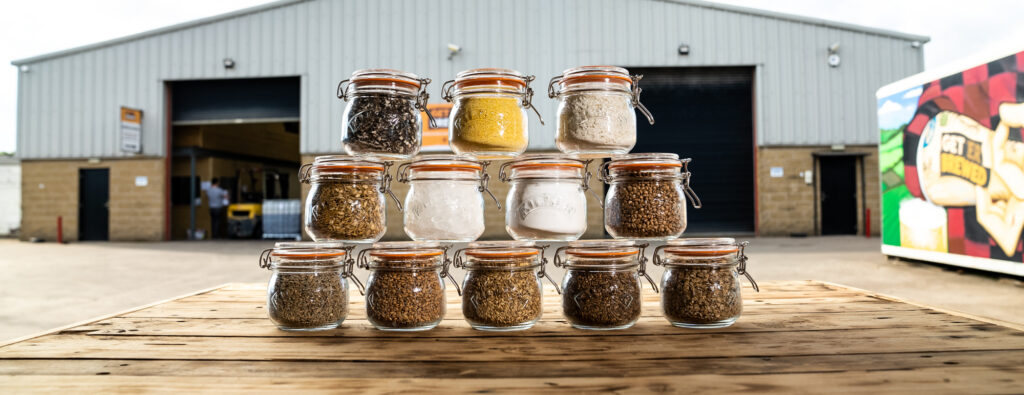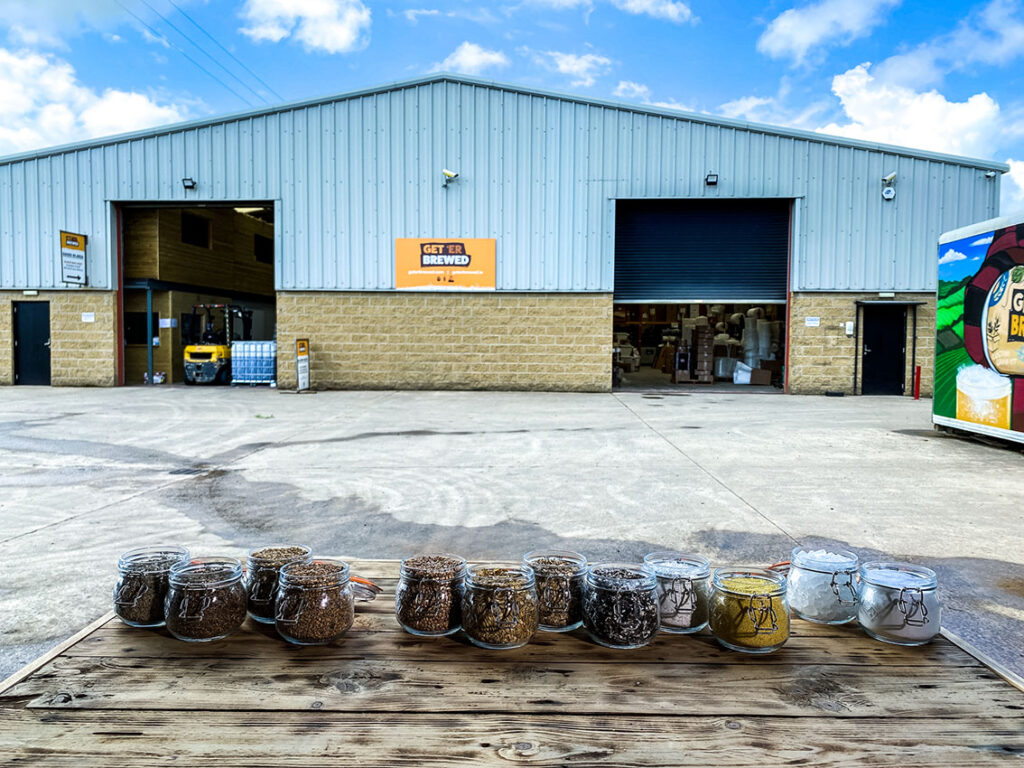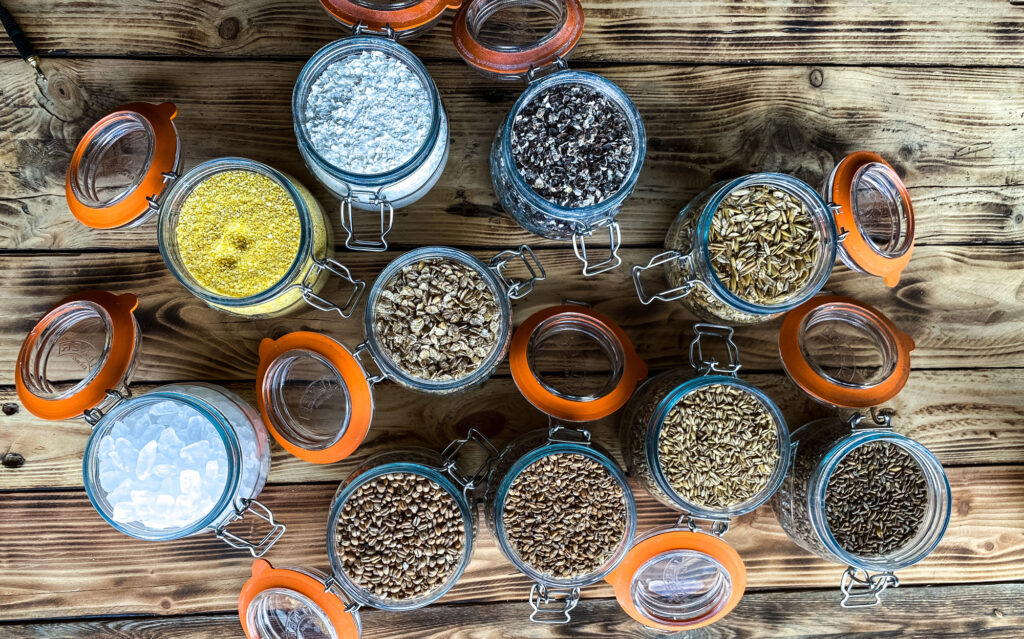
Let us explore ways to improve your beer with brewing adjuncts. What they are and the best way to use them. Thanks to Carl Heron from Crisp for breaking this down for us.
Brewing With Non-malted Adjuncts
Introduction
Brewing adjuncts are a cereal based addition to create an extract that generally hasn’t been malted, with the exception of coloured malt. Adjuncts alone cannot be used to create a good beer for a number of reasons.
- Solid grain adjuncts are not malted
- They have no diastatic power so cannot provide fermentable sugar on their own
- The nitrogen content is proteinaceous and will not provide the essential nutrients required for yeast growth
- Grains will be hard and steely if not subjected to additional processing making them difficult to mill
- Cell wall material will still be present and this will increase the viscosity of wort made from them
- Rice and maize will need to be cooked to gelatinise the starch in them if they haven’t been previously processed
- Solid and liquid sugars are devoid of nitrogen content, they will not support yeast growth and will dilute head forming potential
- Processed cereals will be pre-gelatinised so can be added directly to the grist
Why Use Adjuncts?
- Can add dimensions of flavour and aroma to beer
- Can improve beer foam and mouthfeel
- Will dilute nitrogen content which improves colloidal stability
- Can reduce gluten content in the final beer
- Can increase brewhouse, fermentation and maturation capacity
- Can add colour to the final beer
- Can be a cost-effective source of the extract
Calculating How Much Adjunct to Use
- Un-malted barley and wheat will be non-friable making them difficult to mill and high in beta-glucans;
- Use a separate mill
- Add up to 12% if not using enzyme (beta-glucanase) to avoid slow run-off from the mash tun
- Essentials for good beer
- fermentable sugars (min DP 40)
- a source of amino acids to support yeast growth (min 140ppm)
- a source of polypeptides for foam generation and mouthfeel (min SNR 36%)
- To ensure there are enough of these components, factor in the dilution effect of the adjunct for diastatic power, soluble nitrogen ratio and/or free amino nitrogen
Micronised Cereals
Wheat, barley, rice, maize, oats and even buckwheat can be heat treated to gelatinise the starch and rupture cell walls. The grains can then be used whole (wheat and barley) or flaked.
The grains are fed onto a vibrating belt that passes beneath glowing red ceramic tiles that are heated with gas. The infrared and microwave energy the tiles emit causes the water molecules inside the grains to expand and the starch and cell walls are disrupted.
Whilst still warm the grains are forced through rollers to flake them.
Torrefied Cereals
Using super-heated air flows in a Cabot Cooker has the same effect on the grains as using the microniser. The larger, heavier grains are most suited to this type of process.
As the grains expand their density reduces and they rise through the outlet of the cooker where they can be left whole or be flaked.
Flaked Cereals
- Whole maize is de-germed by tempering with water it is then wet milled and separated to make maize grits for further processing
- Rice has to be de-hulled, and then the bran is removed which contains the pericarp, aleurone layer and germ to make white rice, broken grains tend to be used for brewing
- Oats have to also have be de-husked to create an oat groat, this is then kilned to reduce the lipid content and stabilise it prior to being processed
- All three of the above can be torrefied or steam conditioned and then flaked as can wheat and barley
Brewing Sugar Manufacture
- The brewing syrup process starts with a source of starch;
- rice
- maize
- wheat
- The grains are purified to separate the starch
- Heat, sulphuric acid and amylase enzymes are used to produce;
- high maltose syrup
- high fructose syrup
- glucose or dextrose syrup
- The higher the DE (dextrose equivalent), the sweeter and less viscous the syrup is
- These syrups often need to be stored warm and transferred through trace heated pipework
Darker syrups and solid block sugars are made by blending raw cane and demerara sugars to create varying degrees of inverted glucose
Types of Adjunct
- Specialty barley malts
- Barley
- Wheat
- Oats
- Maize
- Rice
- Brewing syrups and sugars
Specialty Barley Malts
- Highly kilned malts add malty depth they are conventionally kilned for longer and at higher temperatures to develop flavour and colour
- Vienna, can be used up to 100% to produce golden lagers
- Munich, light munich adds malty depth, dark munich otherwise known as
- Crystalline malts add caramel sweetness, they are made by initially stewing germinated malt to convert the starch in the endosperm and then heating to develop flavour and colour
- Roasted malts add nuttiness, toasted, roasted and ashy/burnt flavors. The are made by heating high nitrogen malted barley
- Roasted barley adds astringency and ashiness and is made by heating raw barley
All these products are part of the grist and add extract along with varying degrees of flavour and colour
Barley
- Can be used raw as a flour, or micronized and then flaked
- Blend with the grist, up to 10% flour or 20% as flakes
- Improves head retention, palate fullness and adds a nice bite
- It’s more cost effective than malt and gives the benefits mentioned above
- Keep in mind that it’s not malted so will contain higher levels of beta-glucan and have no diastatic power or free amino nitrogen
Wheat
- Can be used raw as a flour, torrefied or indeed malted
- Blend with the grist, up to 10% flour, 20% as torrefied or 40% in wheat beers
- Improves head retention, palate fullness and adds a subtle cereal note to beers
- It’s more cost effective than malt and gives the benefits mentioned above
- Wheat is higher in protein than barley and additions above 10% may introduce a haze, add more finings if you don’t want the cloudiness
Oats
- Can be malted, micronised or flaked
- Blend with the grist, up to 25% malted, 20% as torrefied or 20% as flakes
- Contribute palate fullness, silky smoothness and add a subtle oaty sweetness to beers
- Oats are great for creating haze and texture in beers
- Oats are high in beta-glucans and will cause viscous worts, flaked variants are the worst, torrefied are less troublesome as the husk helps keep the mash bed open. Use rice hulls if using flaked or malted oats
Maize
- Manufactured as grits (raw) and micronised flakes
- Grits need to be cooked separately as the starch won’t be gelatinized, micronised flakes can be added to the grist. Addition rate can be up to 30%
- Maize is low in nitrogen, it’s gluten free too. Blend with high protein malts or use with extra pale to produce gluten reduced beers. Relatively neutral in flavour.
- Grits are a cost effective source of extract. Maize dilutes nitrogen content
- Maize doesn’t have any diastatic power or soluble nitrogen so the malt used with them needs to be well modified and you need to ensure that head retention isn’t adversely affected
Rice
- Manufactured as polished grains (raw) and micronised flakes
- Broken grains are normally used in brewing and need to be cooked separately as the starch won’t be gelatinized, micronised flakes can be added to the grist. Addition rate can be up to 30%
- Rice is low in nitrogen, it’s gluten free too. Blend with high protein malts or use with extra pale to produce gluten reduced beers. Rice reduces pH and creates a clean crisp finish to beers
- Broken grains are a cost effective source of extract. Rice dilutes nitrogen content and colour
- Rice doesn’t have any diastatic power or soluble nitrogen so the malt used with them needs to be well modified and you need to ensure that head retention isn’t adversely affected
Brewing Sugars
- Liquid sugars need to be kept warm to stop them crystallizing or solidify
- They are added in the kettle late in the boil to boost wort gravity and can be bought wit varying degrees of fermentability, the lower the DE (dextrose equivalent) the less sweet and fermentable
- Solid sugars from granulated sucrose through to the dark and flavoursome block sugars add flavour aswell as gravity
- Block sugars should be dissolved by the wort passing through the underback
- Granulated sucrose should be added late in the boil in the kettle
CONCLUSION
Adjuncts are a great way to get what you want out of your beer. They are an all-natural method to “manipulate” your brew. However, they must be used correctly in order to achieve the desired results. We hope that this post will help you better understand the dos and don’ts of brewing adjuncts.

Check out these great YouTube videos on Adjuncts and Crisp Malts
ADJUNCTS ON YOUTUBE
CRISP MALTS ON YOUTUBE
Have a look at a few adjuncts on our website:
https://www.geterbrewed.com/flaked-and-unmalted-adjuncts/
